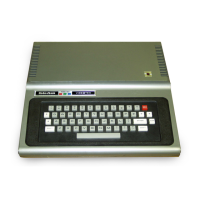
Do you have a question about the Radio Shack TRS-80 Model III and is the answer not in the manual?
| Brand | Radio Shack |
|---|---|
| Model | TRS-80 Model III |
| Category | Desktop |
| Language | English |
Details the computer's components: microprocessor, memory, interfaces, and peripherals.
Covers unpacking, placing the computer, and connecting peripherals like cassette recorders and power.
Explains the procedure for turning on the computer and handling initial start-up prompts like 'Cass?'.
Describes the different operational modes: Immediate, Execute, Edit, and System modes.
Details keyboard layout, special keys, and character input modes (CAPS, ULC).
Explains character size, cursor control, scroll protection, and text/graphics characters.
Covers Cassette, Printer, RS-232-C interfaces, I/O routing, and Real-Time Clock.
Details how to redirect I/O between different devices for program versatility.
Explains the computer's built-in clock, setting, and displaying time and date.
Describes how to reset I/O drivers to their default conditions using SINITIO.
Explains how to reserve memory for Z-80 routines during the start-up dialog.
Lists and describes various ROM subroutines accessible via the USR function for system control and I/O.
Discusses potential power supply issues and recommended solutions for computer operation.
Provides guidance on cleaning the computer and maintaining peripheral devices.
Details power requirements and current drain for the computer system.
Specifies the type and clock rate of the computer's central processing unit.
Lists standard RS-232-C signals, pin assignments, and descriptions.
Defines program elements, data handling, manipulation, and expression construction in BASIC.
Explains essential BASIC commands for program control and execution.
Details statements for interacting with devices like keyboard, display, cassette, and printer.
Covers statements for program flow, variable definition, and error handling.
Explains the structure and usage of arrays for organizing data.
Lists and describes built-in functions for mathematical calculations.
Covers graphics, error routines, and other advanced functions and statements.
Details commands and subcommands for modifying program lines within the BASIC editor.
Provides a summary of special characters, abbreviations, and commands.
Lists and explains common error codes encountered during program execution.
Details ASCII, control, graphics, and special character codes for the TRS-80 display.
Lists decimal, hexadecimal, and binary equivalents for numerical representation.
Offers guidance on adapting Model I BASIC programs for the Model III.
Defines technical terms and concepts related to computer operation and programming.
Explains digital data transmission, signal conventions, and pin designations for the RS-232-C interface.











